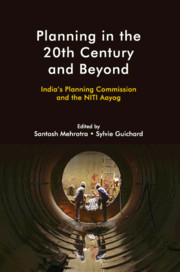Book contents
- Frontmatter
- Contents
- List of Figures
- List of Tables
- List of Abbreviations
- 1 Planning for a 21st Century India
- Part I Origins: Ideas and Ideology
- 2 From Economists to Historians: Studying the Planning Commission, 1950–2014
- 3 The Long Road to Indian Economic Planning (until 1950)
- 4 Ideas and Origins of the Planning Commission in India
- Part II Changes and Continuity: Development and Adaptation of Planning and the Planning Commission
- 5 The Planning Commission and Education
- 6 Addressing Agrarian Distress: Sops versus Development
- 7 Economic Planning after Economic Liberalization: Between Planning Commission and Think Tank NITI, 1991–2015
- 8 Planning Commission: Obiter Dictum
- 9 On a Revived Planning Commission
- Part III Planning Beyond the Planning Commission
- 10 Make in India
- 11 Manufacturing: The Cornerstone of a Planning Strategy for the 21st Century
- 12 Fiscal Planning to Sustain Growth and Poverty Reduction
- 13 Plan, but Do Not Over-plan: Lessons for NITI Aayog
- 14 Why Does India Need a Central Planning Institution in the 21st Century?
- Notes on Contributors
- Index
- References
10 - Make in India
Published online by Cambridge University Press: 04 April 2020
- Frontmatter
- Contents
- List of Figures
- List of Tables
- List of Abbreviations
- 1 Planning for a 21st Century India
- Part I Origins: Ideas and Ideology
- 2 From Economists to Historians: Studying the Planning Commission, 1950–2014
- 3 The Long Road to Indian Economic Planning (until 1950)
- 4 Ideas and Origins of the Planning Commission in India
- Part II Changes and Continuity: Development and Adaptation of Planning and the Planning Commission
- 5 The Planning Commission and Education
- 6 Addressing Agrarian Distress: Sops versus Development
- 7 Economic Planning after Economic Liberalization: Between Planning Commission and Think Tank NITI, 1991–2015
- 8 Planning Commission: Obiter Dictum
- 9 On a Revived Planning Commission
- Part III Planning Beyond the Planning Commission
- 10 Make in India
- 11 Manufacturing: The Cornerstone of a Planning Strategy for the 21st Century
- 12 Fiscal Planning to Sustain Growth and Poverty Reduction
- 13 Plan, but Do Not Over-plan: Lessons for NITI Aayog
- 14 Why Does India Need a Central Planning Institution in the 21st Century?
- Notes on Contributors
- Index
- References
Summary
Introduction
The manufacturing sector has been the relentless focus of India's policymakers, since Independence and the first Industrial Policy Resolution of 1948, right up to 2019 as the Government of India attempts to execute successfully the ‘Make in India’ strategy. In 1948, the share of manufacturing in India's gross domestic product (GDP) was nearly 10 per cent. In 2015–16, it stands at a mere 15 per cent. At its peak, the share of manufacturing approached 20 per cent of GDP in the heyday of the thrust for capital intensive manufacturing in the 1960s and 1970s, but as the economy began to liberalize from the early 1980s, it is the share of services which grew steadily. The share of manufacturing in GDP has remained largely stagnant since 1980 at around 15–16 per cent of GDP.
What is remarkable about the trajectory of manufacturing in India is how little it has changed despite changes in policy over the decades. The 1948 Industrial Policy Resolution based on the ‘Bombay Plan’ stressed a continuous increase in production and an equitable distribution of wealth. The 1956 Industrial Policy Resolution decisively shifted focus to a public sector led basic goods first industrial strategy in order to achieve the goal of a socialist pattern of society. The first baby steps towards liberalization began in 1973, when the Industrial Policy Statement identified industries in which large private sector industrial houses and foreign investors could invest. In 1977, The Janata Party government's Industrial Policy statement emphasized small scale industry and village enterprises. In 1980, at the time of Indira Gandhi's comeback, the Industrial Policy Statement laid the foundation for competition and export orientation for the first time. Finally, in 1991, the Industrial Policy Resolution took a giant step towards liberalization by dismantling industrial licensing for a large number of industries, by permitting 51 per cent foreign direct investment (FDI) in several sectors and by forming a more liberal regime for technology acquisition. Despite all of those twists and turn in India's policies towards manufacturing, the most recent ‘National Manufacturing Policy’ of 2011 laments ‘the share of manufacturing in India's GDP has stagnated at 15–16 percent since 1980 while the share in comparable economies in Asia is much higher at 25–34 percent’.
- Type
- Chapter
- Information
- Planning in the 20th Century and BeyondIndia's Planning Commission and the NITI Aayog, pp. 187 - 207Publisher: Cambridge University PressPrint publication year: 2020



